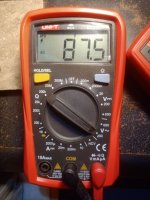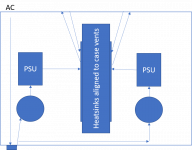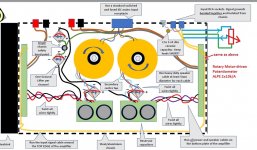Please find attached the simplified PS schematic
Much more information is required as the schematic does not show any reason why there was 65-78 VAC from centre tap to Ground.
You mentioned two amplifiers. Are they both functional? Did you build them?
What are the AC voltages at each transformer centre-tap to secondaries?
Are the bridge rectifiers wired correctly?
What are the DC voltages from V+ and V- to 0V?
Check that that AC L, N, and E are connected properly at AC entry into the amplifier case.
Post pictures.
Hi Ben Mah,
I started performing the tests you prescribed and got expected AC voltages across secondaries and the center tap (21.6 VAC). I also got expected DC voltages after rectification (+- 28.9V DC). I was still seeing high voltages across the center taps and the chassis (safety earth), around 88V AC.
On a whim, I used another multimeter and got a negligible AC voltage across the center taps and the chassis. Can I then attribute this weird reading to a faulty multimeter? Or, am I missing something?
I started performing the tests you prescribed and got expected AC voltages across secondaries and the center tap (21.6 VAC). I also got expected DC voltages after rectification (+- 28.9V DC). I was still seeing high voltages across the center taps and the chassis (safety earth), around 88V AC.
On a whim, I used another multimeter and got a negligible AC voltage across the center taps and the chassis. Can I then attribute this weird reading to a faulty multimeter? Or, am I missing something?
Attachments
Indeed, there are many ways to do this - thanks for sharing.
I came across this (not dual mono, so slighlty OT). It strikes me that this is similar to the NAP200 scheme:
https://www.diyaudio.com/community/threads/point-to-point-wiring-vs-pcbs.291187/post-4733103
For modern commercial amps in volume, you would not use P2P - everything would be on the PCB to reduce costs and to remove the potential for wiring mistakes and/or production variability that comes with P2P. But on big power amps, I don't thing you can get away without some P2P. That said, if you have ever opened a modern Marantz Integrated amp, it has multiple PCB's with cable interconnects.
The rules for minimizing noise and getting quiet amplifiers apply universally - you just have to make sure thee chosen implementation doesn't break the rules.
The rules for minimizing noise and getting quiet amplifiers apply universally - you just have to make sure thee chosen implementation doesn't break the rules.
auriga2001in,
Maybe.
You could test your meters. Perhaps new battery needed?
No other comment possible as you have been very selective in giving out information.
Maybe.
You could test your meters. Perhaps new battery needed?
No other comment possible as you have been very selective in giving out information.
Thanks for sharing the diagram! Very helpful, I haven't been able to find a lot of dual mono wiring schematics.
I am planning an amp using the case from a big AV receiver that has heatsinks/vents down the middle. Would running a power supply on each side have a negative effect? I drew up what I was thinking. I could probably stack both transformers and the power supply boards on one side, it would just get crowded.
I am planning an amp using the case from a big AV receiver that has heatsinks/vents down the middle. Would running a power supply on each side have a negative effect? I drew up what I was thinking. I could probably stack both transformers and the power supply boards on one side, it would just get crowded.
Attachments
What is the advantage of two toroids vs one with the same combined VA rating as two and connected to separate PSU for each channel.
If the larger toroid is occupying less space within the single chassis, could there be a noise performance advantage over two?
If the larger toroid is occupying less space within the single chassis, could there be a noise performance advantage over two?
In this case I'm only using two because that's what I have, not sure whether using one transformer and two power supplies is considered a true dual mono.
Generally, I’m not a fan of Dual Mono. Douglas Self discusses this and I tend to agree with his findings. I get that monoblocs make sense. You put the amp next to the speaker, cables are short etc and you run balanced O/P’s from the pre. (In practice this is rarely the case - most setups put the amps together and run long speaker cables 🙁).
With a dual monobloc, the transformer EM field is spread over two devices so occupies a larger area and you also have lots of opportunity if you are not careful for ground loops and common impedance coupling. Dual mono blocs add nothing in practical terms to channel separation (tests have shown anything > 25 dB is inaudible - again, see Self).
With a dual monobloc, the transformer EM field is spread over two devices so occupies a larger area and you also have lots of opportunity if you are not careful for ground loops and common impedance coupling. Dual mono blocs add nothing in practical terms to channel separation (tests have shown anything > 25 dB is inaudible - again, see Self).
One thought:
I the dual transformers is without centertap, does the rule of the input ground at RCA still apply as shown in the PDF on page1??
I the dual transformers is without centertap, does the rule of the input ground at RCA still apply as shown in the PDF on page1??
That’s funny because most sway to the route of a separate L/R amplifier arrangement due to ground related noise with higher bandwidth amplifiers, and find that it is preferable with two separate amps in one case vs shared rails. Not for separation, packaging or anything else.Generally, I’m not a fan of Dual Mono. Douglas Self discusses this and I tend to agree with his findings. I get that monoblocs make sense. You put the amp next to the speaker, cables are short etc and you run balanced O/P’s from the pre. (In practice this is rarely the case - most setups put the amps together and run long speaker cables 🙁).
With a dual monobloc, the transformer EM field is spread over two devices so occupies a larger area and you also have lots of opportunity if you are not careful for ground loops and common impedance coupling. Dual mono blocs add nothing in practical terms to channel separation (tests have shown anything > 25 dB is inaudible - again, see Self).
I think a single PSU is better. A lot of effort has gone into understanding noise and how to wire stuff up (See Self, Ott et al) so that this is not a problem. I will not argue with anyone over this because a lot of it is down to personal preference!
A decent modern power amp will have high PSRR so if you are paranoid about it, you can always use a ripple eater - see for example Ostripper and dadod designs.
A decent modern power amp will have high PSRR so if you are paranoid about it, you can always use a ripple eater - see for example Ostripper and dadod designs.
The static shield(goss band I presume) on Antek Transformers should be connected to safety ground point I assume.. Is that correct? Thanks!
ok - should work ok. Keep all the wires between the socket and the volume pot tightly twisted and then from the volume put to the amplifier tightly twisted - or use shielded cable (guaranteed to have small loop area).The potentiometer will be near the input RCA sockets
(If I have a concern, it might be that the source impedance for the amplifier is quite high because it comes from the pot centre tap - but try it, and lets see what you get.)
- Home
- Amplifiers
- Solid State
- Wiring Up Dual Mono Amplifier



